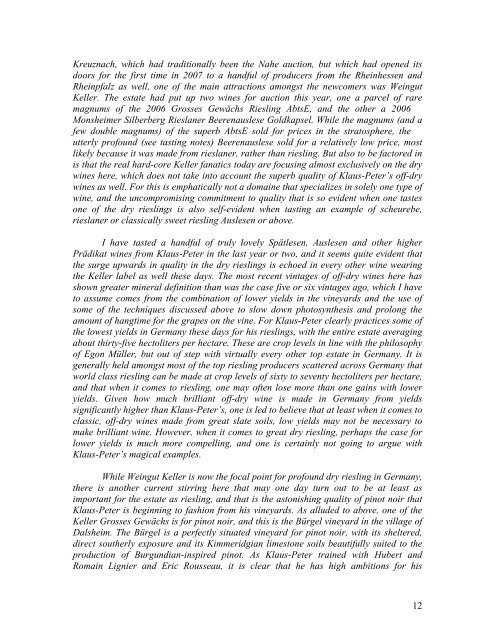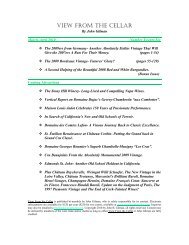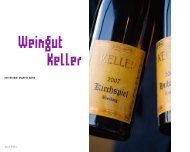View From The Cellar Sept-Oct 2007 - Keller Wein
View From The Cellar Sept-Oct 2007 - Keller Wein
View From The Cellar Sept-Oct 2007 - Keller Wein
You also want an ePaper? Increase the reach of your titles
YUMPU automatically turns print PDFs into web optimized ePapers that Google loves.
Kreuznach, which had traditionally been the Nahe auction, but which had opened its<br />
doors for the first time in <strong>2007</strong> to a handful of producers from the Rheinhessen and<br />
Rheinpfalz as well, one of the main attractions amongst the newcomers was <strong>Wein</strong>gut<br />
<strong>Keller</strong>. <strong>The</strong> estate had put up two wines for auction this year, one a parcel of rare<br />
magnums of the 2006 Grosses Gewächs Riesling AbtsE, and the other a 2006<br />
Monsheimer Silberberg Rieslaner Beerenauslese Goldkapsel. While the magnums (and a<br />
few double magnums) of the superb AbtsE sold for prices in the stratosphere, the<br />
utterly profound (see tasting notes) Beerenauslese sold for a relatively low price, most<br />
likely because it was made from rieslaner, rather than riesling. But also to be factored in<br />
is that the real hard-core <strong>Keller</strong> fanatics today are focusing almost exclusively on the dry<br />
wines here, which does not take into account the superb quality of Klaus-Peter’s off-dry<br />
wines as well. For this is emphatically not a domaine that specializes in solely one type of<br />
wine, and the uncompromising commitment to quality that is so evident when one tastes<br />
one of the dry rieslings is also self-evident when tasting an example of scheurebe,<br />
rieslaner or classically sweet riesling Auslesen or above.<br />
I have tasted a handful of truly lovely Spätlesen, Auslesen and other higher<br />
Prädikat wines from Klaus-Peter in the last year or two, and it seems quite evident that<br />
the surge upwards in quality in the dry rieslings is echoed in every other wine wearing<br />
the <strong>Keller</strong> label as well these days. <strong>The</strong> most recent vintages of off-dry wines here has<br />
shown greater mineral definition than was the case five or six vintages ago, which I have<br />
to assume comes from the combination of lower yields in the vineyards and the use of<br />
some of the techniques discussed above to slow down photosynthesis and prolong the<br />
amount of hangtime for the grapes on the vine. For Klaus-Peter clearly practices some of<br />
the lowest yields in Germany these days for his rieslings, with the entire estate averaging<br />
about thirty-five hectoliters per hectare. <strong>The</strong>se are crop levels in line with the philosophy<br />
of Egon Müller, but out of step with virtually every other top estate in Germany. It is<br />
generally held amongst most of the top riesling producers scattered across Germany that<br />
world class riesling can be made at crop levels of sixty to seventy hectoliters per hectare,<br />
and that when it comes to riesling, one may often lose more than one gains with lower<br />
yields. Given how much brilliant off-dry wine is made in Germany from yields<br />
significantly higher than Klaus-Peter’s, one is led to believe that at least when it comes to<br />
classic, off-dry wines made from great slate soils, low yields may not be necessary to<br />
make brilliant wine. However, when it comes to great dry riesling, perhaps the case for<br />
lower yields is much more compelling, and one is certainly not going to argue with<br />
Klaus-Peter’s magical examples.<br />
While <strong>Wein</strong>gut <strong>Keller</strong> is now the focal point for profound dry riesling in Germany,<br />
there is another current stirring here that may one day turn out to be at least as<br />
important for the estate as riesling, and that is the astonishing quality of pinot noir that<br />
Klaus-Peter is beginning to fashion from his vineyards. As alluded to above, one of the<br />
<strong>Keller</strong> Grosses Gewächs is for pinot noir, and this is the Bürgel vineyard in the village of<br />
Dalsheim. <strong>The</strong> Bürgel is a perfectly situated vineyard for pinot noir, with its sheltered,<br />
direct southerly exposure and its Kimmeridgian limestone soils beautifully suited to the<br />
production of Burgundian-inspired pinot. As Klaus-Peter trained with Hubert and<br />
Romain Lignier and Eric Rousseau, it is clear that he has high ambitions for his<br />
12




